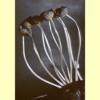.jpg)
images/Coprinus_cordisporus_group/Coprinus_cordisporus_Bougher_(2).jpg
_sml.jpg)

Diagnostic characters
Small agaric, growing on litter, mulch or dung, with a black spore print. Pileus white, pale, brown or grey, plicate, not viscid, covered with powdery or granular veil remnants. Lamellae free. Stipe central. Partial veil remnants absent, but can have a zone of scales at the stipe base from the universal veil. Fruit-body deliquescent (but sometimes not strongly so). Spores rectangular, reddish brown or brown, smooth; germ pore broad. Cheilocystidia present; pleurocystidia present. Lamellar trama regular or interwoven with age. Pileipellis an epithelium; pileocystidia absent. Clamp connections absent.
Similar genera
This is morphologically close to Coprinopsis nivea, due to the presence of a veil and the absence of pileocystidia. It is distinguished from Parasola, which shares a plicate pileus, by the presence of a veil. Compared to most other species of Coprinus sensu lato the spores of C. cordisporus are rather broad, rectangular, and have an apical papilla.
Citation
Coprinus Pers., Tent. Disp. Meth. Fung. 62 (1797).
Australian species
Two species: Coprinus cordisporus and C. patouillardii (the former placed in synonymy with the latter by some authors). This group is keyed out separately because, while it is clear that these two very similar species do not belong in Coprinus in the strict sense, their placement in respect of Coprinellus and Coprinopsis has not been resolved with the available molecular and morphological data.
Citation of species
Coprinus cordisporus Gibbs, Naturalist (Hull) 1908: 100 (1908).
Australian distribution
W.A. and N.S.W. (and probably also N.T., S.A., Qld, Vic. and Tas.).
Habitat
In greenhouses, gardens, parks and farmland. Not confirmed from native forests. Has been recorded overseas after fire.
Substrate
On dung, manured soil, mulch or potting mix.
Trophic status
Saprotrophic.
References
Bougher, N.L. (1983), Western Australian Coprinus as part of a cosmopolitan flora, Trans. Brit. Mycol. Soc. 81: 147–149. [Reports Coprinus cordisporus on horse dung from Western Australia]
Breitenbach, J. & Kränzlin, F. (eds) (1995), Fungi of Switzerland. Volume 4. Agarics 2nd part. Edition Mykologia, Lucerne. [Illustration, Description and Microcharacters of C. patouillardii (including C. cordisporus]
Orton, P.D. & Watling, R. (1979), British Fungus Flora. Agarics and Boleti. 2 / Coprinaceae Part 1: Coprinus. Royal Botanic Garden, Edinburgh. [Description, B&W Illustration and Microcharacters of C. cordisporus and C. patouillardii]
